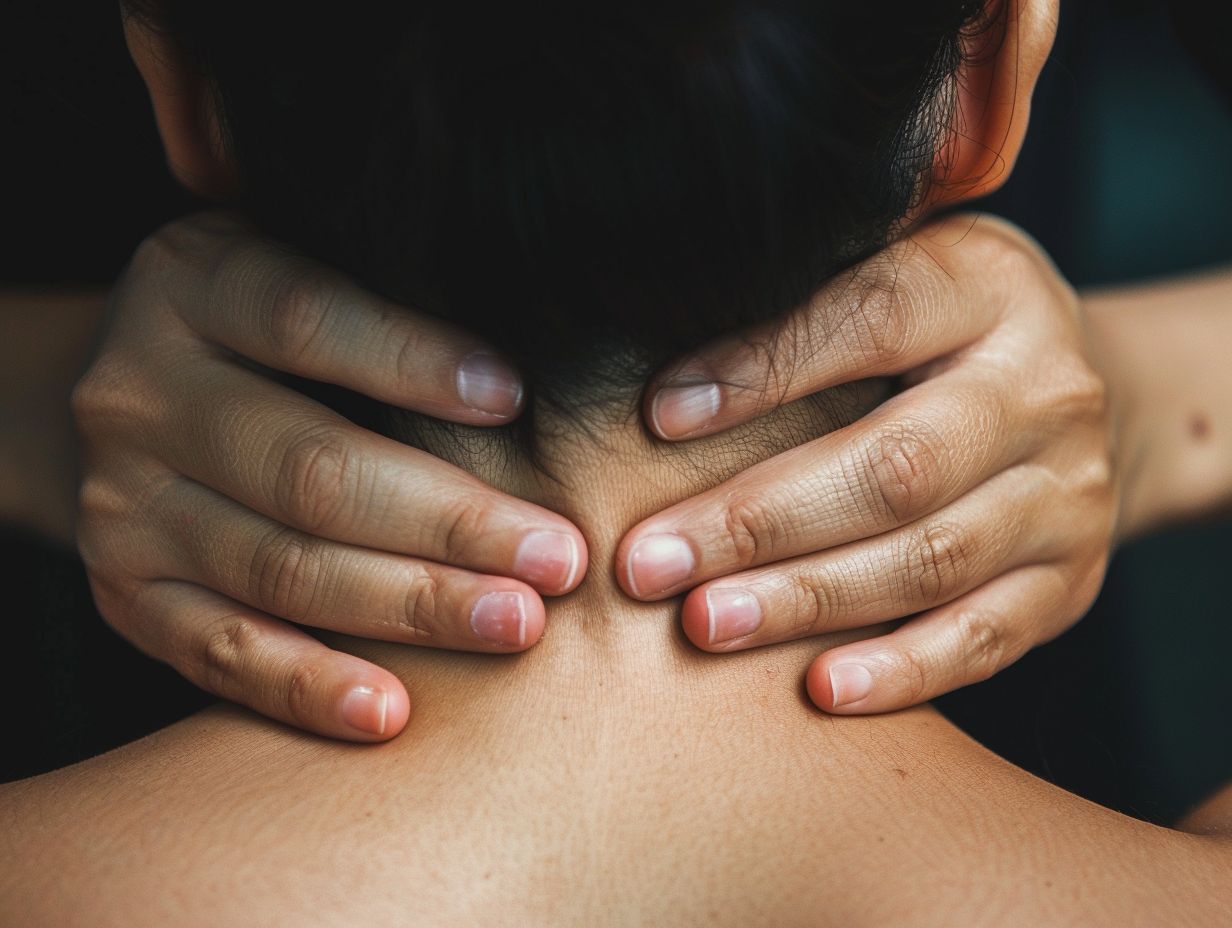Neck pain can be a significant impediment to your daily life and productivity. In this article the causes of neck pain are examined, and effective self-massage techniques for neck pain are introduced to help alleviate the discomfort.
You can discover the Squeeze and Release Technique, Circular Thumb Massage Technique, and the correct method for self-massaging your neck. We offer guidance on posture, hydration, and muscle warm-up to help you bid farewell to neck pain using simple yet effective techniques.
Key Takeaways:
- Regular self-massage can help relieve neck pain caused by muscle tension and stiffness.
- Simple techniques like squeezing and releasing, tilting and turning, and circular thumb massages can effectively target tense neck muscles.
- Remember to warm up your neck muscles, maintain proper posture, and stay hydrated for optimal results when self-massaging your neck.
Understanding Neck Pain
Neck pain can present a significant challenge for individuals as it affects the muscles, tendons, and nerves in the cervical spine. This condition can have various origins, including muscle strains, osteoarthritis, and nerve compression, resulting in sharp or radiating pain.
Those experiencing neck pain may also encounter stiffness, limited range of motion, headaches, and numbness or tingling in the arms. The severity of these symptoms can range from mild discomfort to intense pain that disrupts everyday activities. Common causes of neck pain include muscle strains from poor posture or sudden movements, degenerative changes in the spine due to osteoarthritis, or herniated discs compressing nerves.
It is essential for individuals suffering from neck pain to seek timely medical attention and appropriate treatment to effectively manage and alleviate the discomfort associated with this condition.
Causes of Neck Pain
Neck pain can be attributed to various factors, including poor posture, prolonged screen time resulting in awkward positions, and underlying conditions such as herniated discs or bone spurs.
In today’s digital era, individuals often spend extended periods hunched over their computers or smartphones, leading to strain on the neck muscles and subsequent discomfort. The use of improper ergonomics, such as poorly positioned chairs or desks, can also contribute to neck pain. Insufficient physical activity and exercise can weaken the muscles that support the neck, increasing its vulnerability to pain. Conditions like herniated discs and bone spurs, arising from degenerative changes in the spine, can exert pressure on the nerves in the neck region, resulting in pain and stiffness.
Effective Self-Massage Techniques
Utilizing effective self-massage techniques can offer relief from neck pain and stiffness, presenting a natural alternative to seeking professional massage therapy for alleviating tension headaches and muscle tightness.
Incorporating self-massage practices for the neck region into your daily routine can provide you with the means to address discomfort as it arises. By employing gentle circular motions or applying targeted pressure to specific pressure points, you can effectively release tension and enhance circulation within the neck muscles. This proactive approach can contribute to reducing both the frequency and severity of tension headaches, ultimately fostering relaxation and an overall sense of well-being.
The accessibility and convenience of self-massage render it a cost-effective strategy for managing neck pain and stiffness, offering immediate relief without necessitating a professional appointment.
The Squeeze and Release Technique
The squeeze and release technique is a straightforward yet efficient method for targeting muscle tension in the neck area. You can apply gentle pressure with your thumb and release it to promote relief and relaxation in your neck.
To use this technique effectively, start by identifying the tense areas in your neck where the muscles feel tight or strained. Once you’ve pinpointed these areas, gently squeeze the muscle between your thumb and fingers for several seconds. This action helps increase blood flow and reduce tension in the muscle. When you’re ready to release, slowly let go of the pressure, allowing the muscle to relax. This alternating pressure and release motion can effectively loosen knots and tightness, leading to improved circulation and a sense of relief in the neck region.
Consistent practice of this technique can yield significant benefits for individuals experiencing neck stiffness and discomfort.
The Tilt and Turn Technique
The tilt and turn technique involves gentle movements of your neck, shoulders, and head to release tension in the muscles and improve flexibility. It targets the neck, shoulder blades, and surrounding areas for effective relief.
Performing this technique regularly can lead to increased range of motion in your neck and shoulders, decreased stiffness, and enhanced circulation to the targeted muscles. It is crucial to maintain proper posture throughout the movements to prevent strain and injury, ensuring that the motions are controlled and smooth.
Incorporating the tilt and turn technique into your daily stretching routine can be advantageous for individuals who spend extended periods sitting or working at a desk, as it helps counteract the effects of poor posture and sedentary lifestyle habits.
Circular Thumb Massage Technique
The circular thumb massage technique involves using circular motions with your fingertips to improve blood flow and promote relaxation in your neck area. This technique mimics spa-quality relaxation for effective relief from tension.
By applying gentle pressure and small circular movements with your thumb, this massage helps release built-up tension and tightness in your muscles. These actions stimulate blood circulation, bringing vital nutrients and oxygen to your tissues, aiding in quicker healing and rejuvenation. As your thumb works its way around your neck, it targets key pressure points, promoting a sense of calmness and reducing stress levels. The repetitive nature of the circular motion enhances the release of endorphins, natural painkillers that help alleviate discomfort and promote overall well-being.
The Pin and Stretch Technique
The pin and stretch technique involves applying pressure to tender areas in your neck to trigger immediate relief and reduce sensitivity. Consistency in practicing this technique can lead to lasting benefits for your neck discomfort.
This technique is particularly effective for targeting specific areas of tension in your neck, such as tight muscles or knots. By applying pressure with your thumb and fingers while stretching the muscle, you can release built-up tension and improve blood flow to the area. This targeted approach helps to alleviate pain and enhance flexibility.
It is crucial to maintain a steady hand pressure and gentle stretching motion to maximize the benefits of the pin and stretch technique. With regular application, you can experience improved sensitivity in your neck region and find relief from chronic discomfort over time.
The Fingertip Tapping Technique
The fingertip tapping technique involves using light tapping motions on the neck to promote relaxation and alleviate tension in specific areas. This method takes inspiration from spa theory to offer a calming and efficient self-massage experience.
The gentle tapping approach not only targets tense muscles but also boosts blood circulation, enhancing the overall relaxation benefits. By applying rhythmic taps with your fingertips, you can create a soothing sensation that aids in unwinding and reducing stress.
Incorporating this technique into your wellness routine can contribute to a sense of rejuvenation and mental clarity. With its origins in traditional healing practices, fingertip tapping is thought to balance the body’s energy flow, promoting a holistic well-being approach that goes beyond physical relaxation.
Proper Way to Self-Massage Your Neck
To ensure you are properly self-massaging your neck, it is important to follow specific techniques, check your posture, maintain hydration, perform warm-up routines, and utilize massage balls for targeted relief and relaxation.
When you engage in self-massage for your neck, it is crucial to begin by confirming that your posture is correct. Ensure you are sitting or standing up straight, with relaxed shoulders and your neck in a neutral position. Ahead of starting the massage, engage in gentle warm-up exercises to prepare the muscles and enhance circulation. Hydration plays a vital role in preserving muscle elasticity and overall health, so remember to hydrate by drinking water before and after your massage session. Incorporating massage balls into your routine can offer targeted pressure to alleviate tension and enhance blood circulation in specific areas of your neck.
Check Your Posture
Ensuring your posture is correct is essential for preventing neck pain, especially given the increasing amount of screen time spent on computers and mobile devices. Maintaining proper posture while at your desk or using screens can help alleviate strain on your neck, back, and shoulders.
To reduce the need to bend or strain your neck, make sure your screen is at eye level. Setting up an ergonomic workstation that includes a supportive chair and appropriate desk height can further encourage good posture.
Remember to take regular breaks to stretch and adjust your position, as prolonged sitting can result in stiffness and discomfort. It is recommended to sit with your back straight, shoulders relaxed, and feet flat on the ground to ensure optimal spinal alignment.
Stay Hydrated
Ensuring proper hydration is crucial for maintaining neck health as it facilitates the elimination of toxins, sustains muscle suppleness, and promotes overall well-being. Consuming a sufficient amount of water daily can assist in alleviating neck discomfort.
Water plays a vital role in sustaining optimal body function, particularly in the neck region. Inadequate hydration can result in muscle stiffness and tension in the neck, potentially worsening conditions such as headaches and restricted range of motion. By maintaining a daily intake of 8-10 glasses of water, you can effectively hydrate your body, support muscle functionality, and aid in the detoxification process. Additionally, integrating hydrating fruits and vegetables into your diet can further help fulfill your hydration requirements.
Warm-Up Your Neck Muscles
Before beginning self-massage on your neck, it is advisable to warm up your neck muscles to enhance relaxation and improve the effectiveness of the massage techniques. One way to do this is by using a warm towel or heating pad to provide gentle warmth, which can help prepare the muscles for the therapeutic massage.
Applying warmth to the neck area can have a positive impact by increasing blood flow to the muscles, aiding in relaxation and increasing their pliability. This improved circulation can also assist in easing tension and reducing stiffness in the muscles. By incorporating a warm-up routine into your self-massage practice, you can create a more comfortable and effective experience. The warmth can help in loosening tight knots and trigger points, making it easier to target specific areas of tension during the massage.
Unlocking a Pain-Free Future: Your Journey to Neck Wellness
As we conclude our exploration of neck pain relief through self-massage techniques, it’s clear that the power to alleviate discomfort lies within your own hands. By incorporating these simple yet effective methods into your daily routine, you’re taking a proactive step towards a healthier, more comfortable life. Remember that consistency is key – regular practice of these techniques can lead to significant improvements in neck mobility and pain reduction over time. As you embark on this journey to neck wellness, stay mindful of your posture, hydration, and overall body awareness. Listen to your body, and don’t hesitate to seek professional medical advice if pain persists or worsens. With patience and dedication, you can unlock a future free from the constraints of neck pain, allowing you to fully engage in the activities you love without discomfort holding you back. Embrace these self-massage techniques as tools for empowerment, and look forward to a life where neck pain is a distant memory rather than a daily struggle.

Frequently Asked Questions
How often should I perform self-massage techniques for neck pain?
It’s generally recommended to perform self-massage techniques for neck pain 1-2 times daily, especially if you’re experiencing ongoing discomfort. However, listen to your body and adjust the frequency based on your individual needs and response to the techniques.
Can self-massage techniques replace professional medical treatment for neck pain?
While self-massage techniques can be effective for managing mild to moderate neck pain, they should not replace professional medical treatment, especially for severe or persistent pain. Always consult with a healthcare provider for proper diagnosis and treatment recommendations.
Are there any risks associated with self-massage techniques for the neck?
When performed correctly, self-massage techniques are generally safe. However, be gentle and avoid applying excessive pressure, especially near the spine or arteries. If you experience increased pain, dizziness, or numbness, stop immediately and consult a healthcare professional.
How long should each self-massage session last?
A typical self-massage session for the neck can last anywhere from 5 to 15 minutes. Start with shorter sessions and gradually increase the duration as you become more comfortable with the techniques.
Can I use essential oils or massage creams during self-massage?
Yes, you can use essential oils or massage creams to enhance your self-massage experience. However, ensure you’re not allergic to any ingredients and dilute essential oils properly before application.
What should I do if I experience pain during self-massage?
If you experience pain during self-massage, stop immediately and reassess your technique. Use lighter pressure or try a different technique. If pain persists, consult with a healthcare professional.
Can self-massage techniques help with tension headaches related to neck pain?
Yes, many people find that self-massage techniques for the neck can help alleviate tension headaches. By releasing muscle tension in the neck and improving circulation, these techniques may reduce the frequency and intensity of tension headaches.
Is it normal to hear cracking or popping sounds during neck self-massage?
Occasional cracking or popping sounds during gentle neck movements are generally normal and not a cause for concern. However, if you experience pain or discomfort along with these sounds, stop the massage and consult a healthcare provider.
Can I perform self-massage techniques if I have a pre-existing neck condition?
If you have a pre-existing neck condition, such as a herniated disc or cervical spondylosis, consult with your healthcare provider before attempting self-massage techniques. They can advise you on which techniques are safe and appropriate for your specific condition.
How long does it typically take to see results from regular self-massage for neck pain?
The timeframe for experiencing results can vary depending on the individual and the severity of the neck pain. Some people may notice immediate relief, while others might require consistent practice over several weeks to see significant improvements. Be patient and consistent with your self-massage routine for the best results.




